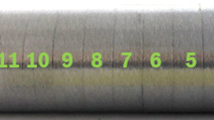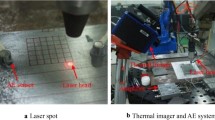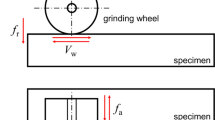Abstract
Grinding burn is a discoloration phenomenon according to the thickness of oxide layer on the ground surface. This study tries to establish an automatic grinding burn detection system with robust burn features that are caused by burn and not by the design parameters. To address this issue, a method based on acoustic emission sensor, accelerator, electric current transducers, and voltage transducers was proposed in an attempt to extract burn signatures. A trial-and-error experimental procedure was presented to find out burn threshold. Vitrified aluminum oxide grinding wheel and AISI 1045 steel workpiece were used in the grinding test, as they were the most commonly used wheel–workpiece combinations in conventional grinding process. With the help of fast Fourier transform and discrete wavelet transform, the spectral centroid of AE signal, the maximum value of power signal, and the RMS of the AE wavelet decomposition transform from wavelet decomposition levels d1 to d5 were extracted as burn features. The spectral centroid of AE signal was believed not to be affected by grinding parameters. A classification and prediction system based on support vector machine was established in order to identify grinding burn automatically. Results indicate that the classification system performs quite well on grinding burn classification and prediction.
Similar content being viewed by others
References
Malkin S, Anderson RB (1974) Thermal aspects of grinding, part 1—energy partition. J Eng Ind 96:1177–1183
Tönshoff HK, Friemuth T, Becher JC (2002) Process monitoring in grinding. CIRP Ann Manuf Technol 51:551–571
Rowe WB, Black SCE, Mills B, Morgan MN, Qi HS (1997) Grinding temperatures and energy partitioning. Proc R Soc Lond Ser A, Math Phys Eng Sci 453:1083–1104
Pavel R, Srivastava A (2007) An experimental investigation of temperatures during conventional and CBN grinding. Int J Adv Manuf Tech 33:412–418
Choi TJ, Subrahmanya N, Li H, Shin YC (2008) Generalized practical models of cylindrical plunge grinding processes. Int J Mach Tool Manu 48:61–72
Malkin S, Guo C et al (2007) Thermal analysis of grinding. CIRP Ann Manuf Technol 56:760–782
Santa-aho S, Vippola M, Sorsa A, Latokartano J, Lindgren M, Leiviskä K, Lepistö T (2012) Development of Barkhausen noise calibration blocks for reliable grinding burn detection. J Mater Process Tech 212:408–416
Teti R, Jemielniak K, O’Donnell G, Dornfeld D (2010) Advanced monitoring of machining operations. CIRP Ann Manuf Technol 59:717–739
Liu Q, Chen X, Gindy N (2005) Fuzzy pattern recognition of AE signals for grinding burn. Int J Mach Tool Manu 45:811–818
Nathan RD, Vijayaraghavan, Krishnamurthy R (1999) In-process monitoring of grinding burn in the cylindrical grinding of steel. J Mater Process Tech 91:37–42
Vedhavalli L, Lavanya TD, Annamalai VE (2007) The presence of carbon content in chips as an indicator of grinding temperature. Mater Manuf Process 22:830–832
Liu Q, Chen X, Gindy N (2006) Investigation of acoustic emission signals under a simulative environment of grinding burn. Int J Mach Tool Manu 46:284–292
Wang Z, Willett P, DeAguiar PR, Webster J (2001) Neural network detection of grinding burn from acoustic emission. Int J Mach Tool Manu 41:283–309
Kwak JS, Ha MK (2004) Neural network approach for diagnosis of grinding operation by acoustic emission and power signals. J Mater Process Tech 147:65–71
Subrahmanya N, Shin YC (2008) Automated sensor selection and fusion for monitoring and diagnostics of plunge grinding. J Manuf Sci Eng 130:031014.1–031014.11
Griffin JM, Chen X (2009) Multiple classification of the acoustic emission signals extracted during burn and chatter anomalies using genetic programming. Int J Adv Manuf Tech 45:1152–1168
Kwak JS, Song JB (2001) Trouble diagnosis of the grinding process by using acoustic emission signals. Int J Mach Tool Manu 41:899–913
Yang ZS, Yu ZH (2012) Grinding wheel wear monitoring based on wavelet analysis and support vector machine. Int J Adv Manuf Tech 62:107–121
Cortes C, Vapnik V (1995) Support-vector networks. Mach Learn 20:273–297
Widodo A, Yang BS (2007) Support vector machine in machine condition monitoring and fault diagnosis. Mech Syst Signal Pr 21:2560–2574
Dunegan HL, Green AT (1972) Factors affecting acoustic emission response from materials. ASTM STP 505, West Conshohocken, pp. 100–113
Author information
Authors and Affiliations
Corresponding author
Rights and permissions
About this article
Cite this article
Yang, Z., Yu, Z. Experimental study of burn classification and prediction using indirect method in surface grinding of AISI 1045 steel. Int J Adv Manuf Technol 68, 2439–2449 (2013). https://doi.org/10.1007/s00170-013-4882-4
Received:
Accepted:
Published:
Issue Date:
DOI: https://doi.org/10.1007/s00170-013-4882-4




